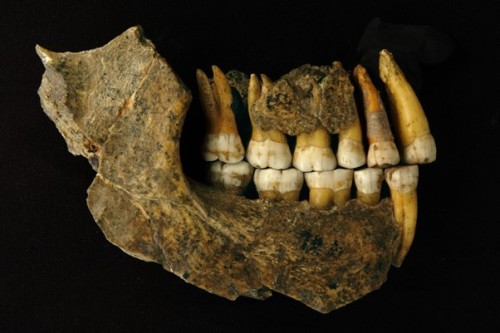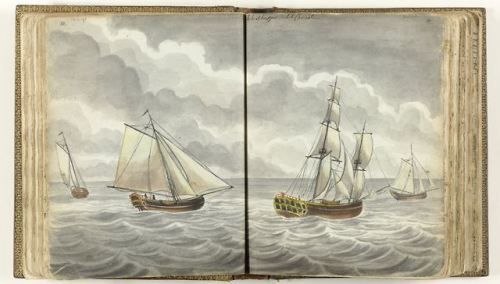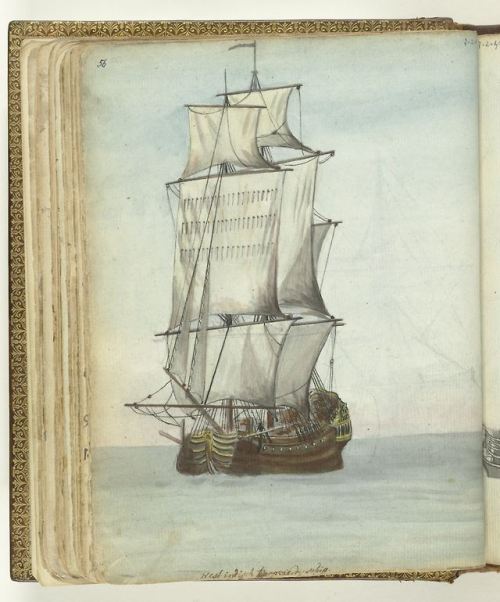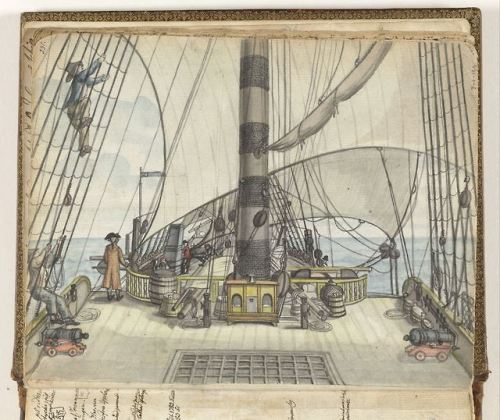#natural sciences



Immediately after the extinction of the dinosaurs ☄️, it was more beneficial for mammals to be big than to be smart, concludes a new study we collaborated on.
It was not until ten million years after the dinosaur era that early representatives of modern mammal groups, such as primates, began to develop larger brains and a more complex range of sensory and motor skills. This would have improved their chances of survival at a time when competition for resources had become much greater.
Read the complete article on our website
[picture 1: a skull from our collections was one of the key fossils for this study in Science. Photo: Thierry Smith]
[picture 2: left is a reconstruction of the Eocene mammal Hyrachyus modestus, a rhinoceros-tapir ancesto, with already bigger brains; right is the small-brained Paleocene mammal Arctocyon primaevus, a carnivorous predator most closely related to the group including living pigs and sheep. Image: Sarah Shelley]
[picture 3: Crania and virtual endocasts of the Paleocene mammal Arctocyon primaevus (left, with smaller brain) and of the Eocene mammal Hyrachyus modestus (right, with bigger brain). Images: Ornella Bertrand and Sarah Shelley]


Not a T. rex but a Sea rex! This is the skull of Prognathodon solvayi.
Flashback to the end of the Cretaceous, some 70 million years ago: when tyrannosaurs ruled the continents, gigantic predatory lizards dominated the warm seas. Prognathodon was one of them. This animal belonged to the mosasaur family.
This nice specimen is very Belgian: it was excavated in 1889 in Ciply near Mons (Hainaut) and described that same year by Belgian paleontologist Louis Dollo (who also studied our Bernissart Iguanodons!). As you can see the skull is very robust, with a long, flexible jaw and sharp teeth. Prognathodon surely had a powerful bite! Turtles, sharks, ammonites, … they all went down its throat!
Prognathodon solvayi was relatively small, barely reaching 5 meters in length, while other species potentially reached 10 metres and more. Mosasaurs in general had long hydrodynamic bodies, flippers for balance and a powerful tail for propulsion (an upside-down shark’s tail, with the fleshy upper lobe smaller than the lower). They were one of the greatest success stories of their time, and it took the mass extinction at the end of the Cretaceous – some 66 million years ago – to wipe them out completely.
This specimen is on display in our Mosasaur Hall. Another Belgian must-see is the near-complete 12.5-metre-long mosasaur skeleton (Hainosaurus bernardi) hanging from the ceiling.




Where do our horses come from? From the Western Eurasian steppes, north of the Caucasus, according to a new genetic study. There, a wild population was domesticated and bred some 4,200 years ago. The domesticated horse conquered in a few centuries the rest of Europe and Asia, replacing all wild populations. The genetic comparison shows that this horse was more docile and had a stronger backbone than its wild ancestor. Characteristics that ensured its success at a time when everyone in the Old World was travelling on horseback.
For the study, published in Nature, the genomes of 273 horses that lived between 52,000 and 2,200 years ago were analysed. One horse bone comes from our collections (pic 4): it was excavated in the 1860s in the Goyet Cave (near Namur) and is 36,000 years old.
Millennia-old specimens continue to yield new information thanks to modern techniques!
More:www.naturalsciences.be/en/news/item/21455/

Nice picture by visitor @faye.pieters in our Gallery of Evolution!
In the background you can see two skeletons of whale ancestors hanging from the ceiling. Whales evolved over some 50 million years from small four-limbed and hoofed land-dwelling mammals to fully-aquatic baleen and toothed whales.
On the right is Maiacetus, that lived some 47 million years ago. It still has four legs and was amphibious: so it could swim, but also walk on land. And to the left of it is Dorudon, which hind legs are already extremely reduced, so it was already fully aquatic some 40 million years ago. Whale evolution is just one stunning science story to tell!
Want to know more? Watch our YT video in which our fossil whale specialist Olivier Lambert explains an important find in Peru illuminating whale evolution and dispersal some 43 million years ago – so in between Maiacetus and Dorudon.
[picture:@faye.pieters]

Very proud of our Gallery of Humankind, our showroom of human life: you can explore our 7 million years of human past and - as you see here - the human body. Studio Louter made these beautiful projections.
This zone openly and honestly explores different life stages, from the embryo to adulthood: fertilisation, pregnancy, birth and the first weeks of life, a child’s rapid growth, the changes that take place during adolescence (to the brain and future reproductive functions) and old age.
[images and videos: @studio_louter]






#FossilFriday! Look at these beautiful fossils of VERY early land plants. They are 420 to 410 million years old (Early Devonian), when plants (along with a few animals) had just conquered the lands. These plants are small… less than 10 cm! They still had a very simple body plan, naked stems dividing a few times, no roots and rudimentary internal transport system for water.
Finding fossil plants of that era is quite exceptional. Our paleobotanist Cyrille Prestianni just documented 15 different species - of which 3 new species! – from South-Africa (the Baviaanskloof Formation). These plants give us a snapshot of what the world looked like when life on emerged lands was still at its very beginning.
These plants are so beautifully preserved, you can see the sporangia: the enclosures in which spores were formed. As if they were about to be dispersed by the wind…
A Belgian-Congolese research team has discovered and documented a community of eastern chimpanzees in three small mountain forests in eastern Congo, near Lake Albert. They counted 283 chimpanzee nests in 18 km2 of forest, and estimate that there are 4,6 chimpanzees per km2. The eastern chimpanzee is endangered. More and more forest is turned into agricultural land. The researchers propose authorities to protect these relict mountain forests in the Albertine Rift and involving local communities from the start.
In East-Congo, in the Province of Ituri, near Lake Albert, lies a mosaic of 20 small montane forests fragments, comprising a total surface of 70 km2. This patchwork of forests is called the RAFALE landscape (Relict Altitude Forests Fragments of the Albert Lake Escarpment). In three selected forest fragments, 18 km2 in total, a Belgian and Congolese research team discovered and documented a surviving community of eastern chimpanzees. The eastern chimpanzee (Pan troglodytes schweinfurthii) is an endangered subspecies.
Touching Discovery
In 2015 biologist Anne Laudisoit (University of Antwerp and now EcoHealth Alliance) was doing research on infectious diseases in the area, when she and local guide Otis Kpanyogo heard chimpanzee cries in a very small patch of forest.
In the two following years she led several multinational expedition teams to observe the chimpanzee population. With camera traps the researchers documented 42 weaned chimpanzees and 10 infants. They walked transects - routes along which observations are made - and counted the chimpanzee nests: 283 in 18 km2. In this way they could estimate the chimpanzee density in those three isolated forests: about 4,6 chimpanzees per km2. That’s more than in comparable forest patches in other regions.
‘Having these unknown and undocumented chimpanzees in front of you, and on camera, was just an incredible discovery, and touched every team member’, says Anne Laudisoit, who – together with photojournalist Caroline Thirion – produced a documentary about the chimpanzee community, entitled: Mbudha, in the chimpanzees footsteps.
Protecting Chimpanzees
This RAFALE chimpanzee community, including the Mbudha community in the three forests investigated, is endangered as more and more forest is turned into agricultural land – by slash-and-burn – to grow cassava, groundnuts, beans, maize and sorghum and feed the densely populated communities in the area.
The authors of this study hope that authorities will recognize the RAFALE landscape as a new Chimpanzee Conservation Unit. They would like to see local communities assisted in the design of a sustainable conservation plan for the benefit of both people and wildlife. ‘These small forests are sacks full of life’, says biologist Erik Verheyen (University of Antwerp and Royal Belgian Institute of Natural Sciences). ‘The protection of this area would also help the conservation of the vulnerable Oustalet’s red colobus monkey and the endangered pangolins as well as 26 other mammal species we recorded in this area.’
The study of the Mbudha chimpanzees and their habitat has only just begun. This Spring 2021, Laudisoit (funded by a National Geographic Grant to pursue the explorations) and a team of biologists are undertaking a new expedition to the area and already observed another 15 chimpanzees. One of the goals is to understand how the Mbudha population is genetically connected to or isolated from others in the region.
The Congolese and Belgian researchers involved in this study published their results in the journal Conservation Science and Practice. The team consisted of biologists from Kisangani University (UNIKIS), Centre de Surveillance de la Biodiversité (CSB), Centre for International Forestry Research (CIFOR), University of Antwerp (UAntwerp), Antwerp Zoo Centre for Research and Conservation (CRC), Royal Belgian Institute of Natural Sciences (RBINS) and EcoHealth Alliance.
Belgian Neanderthal remains, including the world-famous Neanderthals of Spy, are thousands of years older than previously assumed. This is the conclusion of an international research team that re-dated the Belgian Neanderthal remains with a new technique. This discovery implies that Neanderthals disappeared from Belgium much earlier than thought and are therefore no longer the youngest Neanderthals in Europe.
The robust Neanderthals dominated Europe and Asia until about 50,000 years ago, until modern humans replaced them. Neanderthals also lived in our regions. Numerous finds in the Walloon Meuse basin bear witness to this. The Neanderthals of Spy, which are kept in the Royal Belgian Institute of Natural Sciences (RBINS), are said to be the youngest in Europe at 37,000 years old. However, a new study led by Oxford University, in which the RBINS also collaborated, has now shown that Belgian Neanderthals disappeared from the region between 44,200 and 40,600 years ago, much earlier than previously assumed. Contamination of the samples would have been the cause of the incorrect dating.
A new method
A multidisciplinary team of archaeologists, geologists, geneticists, and anthropologists re-dated Neanderthal fossils from the Spy cave and two other Belgian sites, Fonds-de-Forêt ((including a femur preserved at the RBINS) and Engis. They used a new dating method in which only the amino acid hydroxyproline is dated. This method limits the risk of contamination by, for example, glue. The results show that Neanderthal remains are older than previously thought, in some cases even 10,000 years older.
For example, the team discovered that a shoulder blade from a Spy Neanderthal (preserved at the ULiège), which had previously yielded very recent data (around 28 000 years ago), was heavily contaminated with bovine DNA. The results suggest that the bone was preserved with an adhesive prepared from bovine bones. ‘These new chemical methods are the only way we can remove contamination from the samples with certainty,’ says Thibaut Devièse (University of Oxford), first author of the study. 'The molecules we date come only from the bone, and not from other sources.’
Cultural transition
'Dating is crucial in archaeology,’ stresses Tom Higham (University of Oxford), who leads the PalaeoChron research project, 'because without a reliable chronological framework, we can’t really understand the relationships between Neanderthals and Homo sapiens. When Homo sapiens moved into Europe 45,000 years ago, Neanderthals began to disappear. These new methods are hugely important to investigate this transition’.
'Dating all these Belgian specimens was very exciting’, says Grégory Abrams, of the Scladina Cave Archaeological Centre in Belgium. 'They played a major role in the understanding and the definition of Neanderthals. Almost two centuries after the discovery of the Neanderthal child of Engis, we were able to provide a reliable age.’
The team is now analyzing archaeological evidence, such as bone tools, to further refine our picture of the cultural transition between Neanderthals and Homo sapiens in our region.
So now Spy’s Neanderthals are no longer the most recent in Europe, but inevitably the young Neanderthal fossils from Gibraltar, Catalonia and south-west France will also be (re)dated using the new technique.
The study was published in the journal PNAS.
Based on the press release from the University of Oxford and the Scladina Cave Archaeological Center.
Post link
Four of our scientists in the spotlight for Women In Science Day. They represent all the women that our research institute is building on!
⛏️⛏️⛏️
Renata Barros is one of our geologists. She specializes in the role of geological resources and subsurface use in the transition to a more sustainable future.
“Geology dictates where many our natural resources are coming from, such as the water we drink, the heat that can give us renewable energy, or the metals used in solar panels, wind turbines and batteries. An efficient and sustainable use of such resources is now more important than ever. Geological knowledge can also help us to develop smart and sustainable solutions making use of the vast volumes of rock we have under our feet, for example storing CO2. The possibilities are endless!”
Renata is currently coordinating the GeoConnect³d project, that will create an open-access knowledge system gathering geological data from all around Europe in an experience somewhat like Google Earth. One of the main goals of this system: to make geology more understandable.
‘Since I was a child, I have always been attracted to the sea and underwater life,’ says Geneviève Lacroix. ‘And I was strong in mathematics, physics and computer science. I find all these combined in my work here at the Institute.’
But what exactly does she do? She develops mathematical models with which, for example, we can predict the impact of climate change on the dispersion of fish larvae. Or how an excess of nutrients in rivers can cause algae blooms in the sea. Or how the washing of exhaust gasses from ships contributes to the acidification of the North Sea.
“The aim is to protect and improve the marine ecosystem. We advise policy makers and inform the general public about this. I love what I do. There are also the sampling campaigns with the research vessel Belgica. And diving of course!”
Karin Breugelmans holds the keys of our DNA Lab, which was founded in 1991 and has expanded considerably in the meantime. In the lab, there is usually a constant stream of students and researchers from all corners of the world. Many have taken their first steps in DNA research here. It is great to be able to guide them.
Many discoveries have been made here. By studying the DNA of animals, we can reconstruct how they evolved, or how certain characteristics arose. DNA analysis helps to identify specimens or to describe new species.
‘30 years of the DNA lab… let’s throw a party (when we are allowed to do so again)!’
Camille Locatelli is a digitization expert at our Scientific Heritage Service. Her speciality is the digitization of insects and other invertebrates, both fossil and recent. Using the Micro-CT technique (micro–computed tomography) and 3D software she can visualize collection specimens in 2D and 3D. She can even make internal features visible, without damaging the specimen!
“Digitizing natural science collections is a daily pleasure. You develop a special bond with specimens that have been kept in our collections all these years. Some of them arrived over 100 years ago and never left. Digitization allows us to rescue them from oblivion, to give them a second life, eternally this time!“
"For me, the most beautiful specimens to digitize are the smallest ones, even though they can be a real challenge! With the naked eye, they can sometimes be mistaken for simple crumbs or dust. To discover the sublime details of these tiny particles is just an amazing feeling, every single time.”
Check out our digitization work at virtualcollections.naturalsciences.be
Post link
The world of Jan Brandes, 1743-1808 : drawings of a Dutch traveller in Batavia, Ceylon and Southern Africa. This two-part album contains all sorts of drawings he made during his travels. He has drew everything from animals, ships, people to other objects.
Post link











